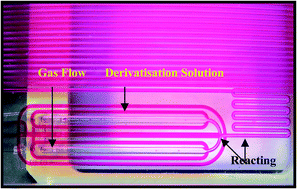Detecting Al3+ with the naked eye
Aluminium has many widespread applications including, packaging materials, food additives, clinical drugs, water purification, building construction etc. Too much Al can cause damage to the central nervous system, and is believed to have a role in neurodegenerative diseases such as Alzheimer’s disease and Parkinson’s disease. Debasis Das and colleagues from The University of Burdwan, India, have developed a highly sensitive fluorescent probe that can detect Al3+, with a green glow that can be seen by the naked eye. Click on the link below to read more.
An Al3+ induced green luminescent fluorescent probe for cell imaging and naked eye detection
Debasis Karak, Sisir Lohar, Animesh Sahana, Subarna Guha, Arnab Banerjee and Debasis Das
Anal. Methods, 2012, Advance Article
DOI: 10.1039/C2AY25226K
Measuring gas phase formaldehyde
Xiaobing Pang and Alastair C. Lewis from the University of York have developed a microfluidic lab-on-chip derivatisation technique and optimized it to achieve a quick and sensitive determination of ambient gaseous formaldehyde when combined with GC-MS. Formaldehyde plays an important role in atmospheric chemistry and is a common pollutant of indoor air. As such, developing a quick and accurate method of detecting it is crucial. Click through on the link below to read more about this important research.
A microfluidic lab-on-chip derivatisation technique for the measurement of gas phase formaldehyde
Xiaobing Pang and Alastair C. Lewis
Anal. Methods, 2012, Advance Article
DOI: 10.1039/C2AY25028D












